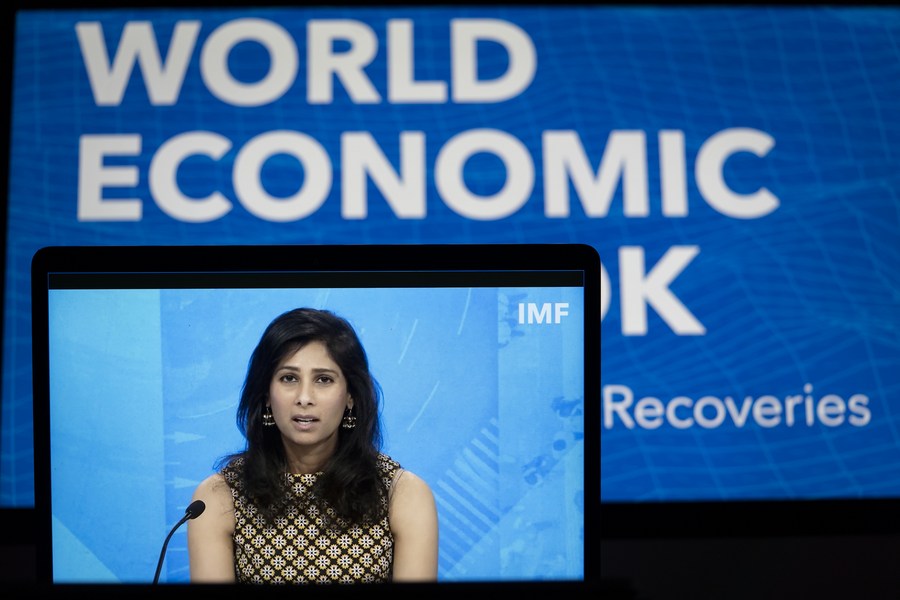IMF upgrades global growth forecast to 6 pct, highlights divergence in recovery

International Monetary Fund (IMF) Chief Economist Gita Gopinath speaks at a virtual press briefing during the World Bank/IMF Spring Meetings in Washington D.C., the United States, April 6, 2021. (Xinhua/Liu Jie)
-- The IMF expected the global economy to grow by 6 percent in 2021, but warned recoveries are diverging dangerously across and within countries.
-- The United States would be the only large advanced economy projected to surpass the level of GDP it was forecast to have in 2022. It is expected to grow by 6.4 percent this year.
-- China is projected to grow by 8.4 percent in 2021, 0.3 percentage point above the January forecast.
WASHINGTON, April 6 (Xinhua) -- The International Monetary Fund (IMF) on Tuesday projected that the global economy will grow by 6 percent in 2021, 0.5 percentage point above the January forecast, according to the latest World Economic Outlook (WEO).
"Thanks to the ingenuity of the scientific community, hundreds of millions of people are being vaccinated, and this is expected to power recoveries in many countries later this year," IMF Chief Economist Gita Gopinath told a virtual press briefing during the World Bank/IMF Spring Meetings.
She noted that economies also continue to adapt to new ways of working despite reduced mobility, and large economies, particularly the United States, have rolled out additional fiscal support, both of which have helped improve the outlook.
Nonetheless, the future presents "daunting" challenges, said the IMF chief economist. "The pandemic is yet to be defeated and virus cases are accelerating in many countries," she said.
Noting that there's uncertainty surrounding the forecast, Petya Koeva Brooks, deputy director of the IMF's Research Department, told Xinhua in a remote interview Tuesday that the chief source of that uncertainty is the path of the pandemic and the vaccination process.
In the baseline, the IMF assumes that there's wide availability of vaccines in the second half of this year in advanced economies, as well as some emerging markets, but for the rest of the world, the wide availability would occur only in 2022 or even beyond, Brooks said.
In a downside scenario, with delayed vaccination and a more difficult path of the pandemic, global economy is expected to grow by 4.5 percent, 1.5 percentage points lower than in the baseline projection, according to Brooks.
At the virtual press conference, Gopinath told reporters that recoveries are diverging dangerously across and within countries, as economies with slower vaccine rollout, more limited policy support, and more reliant on tourism do less well.
She urged policymakers to take a "tailored" approach in providing support, with policies well-calibrated to the stage of the pandemic, the strength of the economic recovery, and the structural characteristics of individual countries.
"Governments will need to build back the fiscal positions after this crisis. And the hope is that they will build forward better to have more inclusive, sustainable, green economies," said the IMF chief economist.
The WEO report also noted that uneven recoveries are occurring within countries as young and lower-skilled workers "remain more heavily affected," and women have also suffered more, especially in emerging market and developing economies.

Photo taken on March 30, 2021 shows an exterior view of the International Monetary Fund (IMF) headquarters in Washington, D.C., the United States. (Photo by Ting Shen/Xinhua)
"In the next stage, what would be most important is to kind of withdraw those (job retention) schemes gradually, and then to help people reallocate, acquire new skills, which would make them competitive in the new sector," Brooks told Xinhua.
The latest WEO showed that the United States would be the only large advanced economy projected to surpass the level of gross domestic product (GDP) it was forecast to have in 2022 in the absence of this pandemic. The U.S. economy is expected to grow by 6.4 percent this year, after a 3.5-percent contraction in 2020.
Other advanced economies, including those in the euro area, will also rebound this year but at a slower pace, the report noted.
Among emerging markets and developing economies, China is projected to grow by 8.4 percent this year, 0.3 percentage point above the January forecast, according to the report.
The upward revision, Gopinath said, reflects improved external environment, with stronger global growth and U.S. COVID-19 relief package, which have increased the demand for China's products.
Noting that China has seen a very strong recovery, the IMF chief economist said the recovery is "somewhat unbalanced," as it's still heavily reliant on public support and public investment, and private consumption has not recovered as fast as hoped.
"So, to make this a durable recovery, our hope is that fiscal measures and other support measures would work in the direction of supporting the recovery coming from the private sector, as opposed to the public sector," she said.
Noting that withdrawing policy support prematurely would expose the economy to additional risks, Brooks advised Chinese policymakers enhance the safety net, which would enable China to be on the rebalancing path, and benefit the economy in the medium to long run.
While China's economy had already returned to pre-pandemic GDP in 2020, many other emerging markets and developing economies are not expected to do so until 2023, the WEO report showed.
The newly released report projected the global economy to expand 4.4 percent in 2022, 0.2 percentage point above its January forecast. In 2020, global economy saw an estimated historic contraction of 3.3 percent, according to the IMF.
Photos
Related Stories
- IMF approves 271 mln USD loan to Namibia to address COVID-19 pandemic
- U.S. Treasury works with IMF on SDR allocation to help low-income countries
- IMF chief sees multi-speed global recovery increasingly powered by China, U.S.
- IMF executive directors discuss SDR allocation of 650 bln USD to boost post-pandemic global recovery
- IMF chief calls for strong G20 policies to counter "dangerous divergence"
Copyright © 2021 People's Daily Online. All Rights Reserved.










